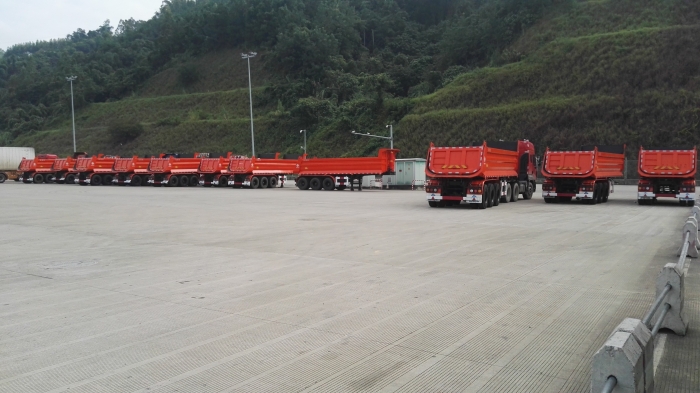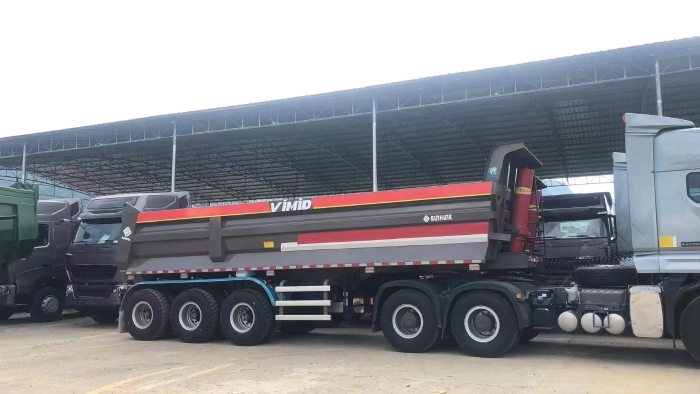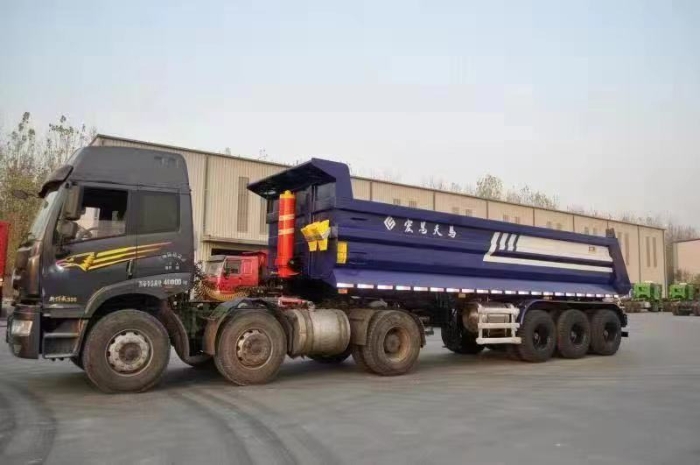- PRODUCTS
- SOLUTION
- SERVICE
- NEWS
- ABOUT US
Yes, double-decker semi-trailers efficiently optimize cargo space, doubling volume capacity without exceeding weight limits.

Double decker semi trailers stand out due to their innovative design, which allows for the transportation of a larger volume of goods in a single trip. Central to this design is the dual-level structure, which effectively doubles the available space for cargo. Manufacturers achieve this by incorporating two decks that can be either fixed or adjustable, catering to various cargo heights. This versatility ensures that both levels optimize space for different types of goods, from palletized merchandise to taller items.
Key Components and Load Mechanism
The structural integrity of double decker trailers rests on robust frameworks, often made from high-strength steel or lightweight aluminum to balance durability and efficiency. The inclusion of a hydraulic lifting system is crucial, enabling the upper deck to raise or lower, facilitating easy loading and unloading of goods. This system not only increases operational efficiency but also ensures safety during the loading process.
Furthermore, advanced locking mechanisms secure the upper deck in place, whether it's adjusted for height or fully loaded, ensuring the cargo's stability during transport. The trailers also feature reinforced flooring to support heavy loads, with anti-slip surfaces to enhance safety.
Space Optimization
When compared to traditional single-decker semi trailers, double deckers offer a significant advantage in cargo space. For instance, a standard double decker can accommodate up to 100% more pallets than its single-decker counterpart. Specifically, while a single-decker might transport approximately 26 pallets, a double decker can handle up to 52, depending on the configuration and the size of the pallets.
Efficiency and Economic Benefits
This increased capacity translates directly into cost savings and reduced environmental impact. By doubling the cargo volume per trip, companies can halve the number of trips required, leading to substantial savings in fuel costs and a reduction in CO2 emissions. For example, reducing trips from two to one for a 500-mile journey can save approximately 100 gallons of diesel fuel, based on an average consumption rate of 6 miles per gallon for loaded semi-trailers.
Moreover, the ability to transport more goods in a single journey optimizes logistical operations, leading to better utilization of resources and improved delivery times. This efficiency is particularly crucial in industries where time-sensitive delivery is paramount.
Transitioning to Enhanced Cargo Solutions
In conclusion, double decker semi trailers represent a leap forward in transportation and logistics, offering a practical solution to the challenge of maximizing cargo space while maintaining efficiency and sustainability. As the demand for transportation grows, these trailers are set to play a pivotal role in shaping the future of logistics, proving that innovative design can lead to significant improvements in operational efficiency and environmental conservation.
For more detailed information on the structural components and operational mechanisms of double decker semi trailers, consider exploring the Wikipedia page on semi-trailers.

Optimizing cargo space plays a pivotal role in enhancing the efficiency and profitability of freight transportation. Double decker semi-trailers offer a revolutionary approach to maximizing cargo space, directly impacting overall logistics performance. This section delves into the space utilization rate and loading and unloading efficiency of double decker semi-trailers, highlighting their benefits over traditional single deck trailers.
Double decker semi-trailers excel in optimizing cargo space through innovative space configuration and adjustable decking systems. These trailers are designed to accommodate two levels of cargo, effectively doubling the available space for freight without exceeding legal height limits. The key to their efficiency lies in the flexibility of the adjustable decking, which can be tailored to fit the specific height requirements of different types of cargo, ranging from palletized goods to taller items.
For instance, a standard double decker trailer might offer up to 100 cubic meters of space, compared to 50 cubic meters in a traditional semi-trailer. This capacity increase allows for transporting up to 100% more cargo in a single journey, significantly reducing the cost per unit of freight transported. Furthermore, the use of lightweight materials in the construction of these decks ensures that the increase in cargo capacity does not come at the expense of fuel efficiency.
The efficiency of loading and unloading operations is crucial for minimizing downtime and enhancing the overall logistics chain. Double decker semi-trailers feature advanced loading systems that streamline these processes. Hydraulic lift systems enable the easy adjustment of the upper deck height, allowing for quick and efficient loading and unloading of cargo. This system significantly reduces the time required to prepare the trailer for transport, leading to shorter turnaround times and higher productivity.
Moreover, the integration of roller systems and powered conveyors in some models further enhances the efficiency of moving goods on and off the trailer. These technologies reduce manual handling requirements, lowering the risk of injury and speeding up the loading and unloading process. As a result, double decker semi-trailers can offer significant improvements in operational efficiency, with loading times reduced by up to 50% compared to traditional trailers.
In conclusion, double decker semi-trailers represent a significant advancement in cargo space optimization. Their innovative design allows for substantial increases in cargo capacity, while advanced loading systems ensure that this extra capacity does not come at the cost of efficiency. These trailers are a testament to the continuous evolution of the logistics industry, offering tangible benefits in terms of space utilization, cost efficiency, and operational productivity. For more detailed insights, Wikipedia offers a comprehensive overview of semi-trailers and their impact on transportation logistics.
The evaluation of double-decker semi-trailers' economic efficiency involves detailed scrutiny of fuel efficiency and cost savings per transport, alongside the maintenance expenses incurred during their operational life. This analysis aims to provide a concrete understanding of how double-decker semi-trailers can be a cost-effective solution for freight transport.
Fuel Efficiency and Cost Savings: Double-decker semi-trailers stand out for their ability to haul more goods per trip, directly impacting fuel efficiency. For instance, by accommodating up to twice the volume of cargo compared to traditional trailers, they can effectively halve the fuel cost per unit of cargo transported. Data from transportation studies indicate that double-decker trailers can lead to fuel savings of 10-20% per cargo unit, assuming optimal loading and highway conditions.
Operational Cost Savings: Beyond fuel, the increased cargo capacity of double-decker trailers significantly reduces the number of trips required for the same amount of cargo. This reduction in trips translates to lower overall operational costs, including wear and tear on vehicles, toll fees, and driver wages. For a company transporting 10,000 units of cargo annually, using double-decker trailers can reduce the total number of trips by up to 50%, leading to substantial cost savings.

Maintenance Expenses: While the initial purchase cost of a double-decker semi-trailer might be higher than that of a standard trailer, the long-term maintenance costs need careful consideration. The sophisticated loading systems and the additional structural components of double-decker trailers can introduce higher maintenance expenses. However, when spread over the increased cargo capacity and operational efficiency, these costs often represent a minor increase in the cost per transported unit. Industry reports suggest an average increase in maintenance costs of 5-8% compared to standard trailers, which is offset by the significant transport efficiency gains.
Economic Impact on Overall Efficiency: The strategic deployment of double-decker semi-trailers can significantly enhance a transport operation's economic efficiency. By evaluating the total cost of ownership, which includes purchase, operation, and maintenance costs, against the benefits of increased capacity and reduced fuel consumption, businesses find that double-decker trailers offer a compelling return on investment. Calculations often reveal that the break-even point can be achieved within the first 2-3 years of operation, with substantial cost savings thereafter.
In conclusion, double-decker semi-trailers present an attractive proposition for freight transporters looking to optimize costs. Their design not only maximizes cargo space but also contributes to notable reductions in fuel consumption and operational expenses. When considering the slightly higher maintenance costs, the overall economic benefits clearly justify the investment in double-decker technology, making them a valuable asset in the logistics and transportation industry.
The use of double-decker semi-trailers in transporting various types of cargo has reshaped logistics strategies, offering unique advantages and facing certain operational constraints. This section delves into the adaptability of double-decker semi-trailers across different cargo categories and the operational limitations that might influence their efficiency in real-world applications.
For Heavy Goods: Double-decker semi-trailers excel in transporting heavy goods, leveraging their robust design to accommodate substantial weight. However, the distribution of heavy cargo requires careful planning to maintain balance and avoid overloading the lower deck. For instance, evenly distributing a load of up to 20 tons across both decks ensures safe and efficient transport, maximizing space without compromising vehicle stability.
For Light Goods: The real advantage of double-decker trailers becomes apparent with light goods, which often occupy more volume than weight. These trailers can double the transport capacity for items such as electronics, furniture, and packaged goods, without exceeding weight limits. This capability enables the transportation of up to 40% more volume than standard trailers, significantly reducing the cost per unit of transported goods.
For Special Cargo: Special cargo, including oversized items or goods requiring controlled conditions, poses unique challenges. Double-decker semi-trailers, equipped with adjustable decks and climate control systems, offer flexible solutions for such demands. They can accommodate items up to 3 meters in height on the lower deck, while the upper deck can be adjusted or removed for taller cargo, providing a versatile transport solution.
Height Restrictions: One of the primary limitations of double-decker semi-trailers is the height restriction. Roads with low bridges or tunnels limit the routes these trailers can take, necessitating detailed route planning. The maximum allowable height in many regions is 4.5 meters, requiring adherence to specific pathways to avoid infrastructure damage.
Weight Limits: While double-deckers optimize space, they must still comply with national and international weight regulations. The total loaded weight cannot exceed the legal limit, which is typically around 44 tons for the truck and trailer combined in many countries. This constraint requires meticulous weight distribution across both decks to utilize the full capacity of the trailer without violating weight restrictions.
In essence, double-decker semi-trailers offer a flexible and efficient solution for a wide range of transport needs, from heavy and light goods to special cargo. Despite facing height and weight limitations, strategic planning and innovative design adaptations allow these trailers to navigate the complexities of modern logistics, offering a compelling option for optimizing cargo transportation.